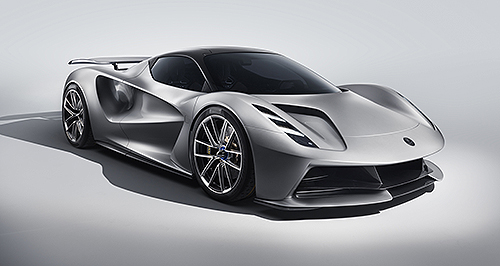Make / Model Search
Future models - Lotus - EvijaLotus reveals 1471kW Evija hypercarElectric Lotus Evija to be world’s most powerful production car from 202017 Jul 2019 LOTUS Cars’ first all-electric hypercar, the Evija, has a target power output of 1471kW, which – if achieved as planned – will make it the most powerful production car in the world.
Unwrapped at an event in London overnight and due to go into production in the United Kingdom next year in a limited run of just 130 units, the carbon-fibre Evija apparently can speed from zero to 100km/h in under three seconds and hit 300km/h in less than nine seconds before topping out at 320km/h.
Lotus Cars Australia chief operating officer Richard Gibbs told GoAuto that three prospective buyers from Australia had registered their interest in the car.
“Maybe one or more of the cars will come to Australia, but we don’t know yet,” he said.
Its peak power output eclipses the 8.0-litre Bugatti Chiron’s 1103kW, as well as the 1416kW of the electric Pininfarina Battista and 1408kW of the Rimac C Two.
However, the Evija’s peak torque of 1700Nm falls short of the 2300Nm produced by both the Battista and Rimac C Two.
Lotus Cars CEO Phil Popham said the Lotus Evija was a car like no other.
“It will re-establish our brand in the hearts and minds of sportscar fans and on the global automotive stage,” he said. “It will also pave the way for further visionary models.”
The hand-built Evija is being bankrolled by Chinese motor company Geely, which bought the 71-year-old British brand from a Malaysian investment company in 2017, adding it to its stable of brands that also includes Volvo.
The Evija – meaning ‘the first in existence’ or ‘the living one’ – is powered by a 70kWh battery that should deliver a range of 400km. Four electric motors drive all four wheels, with each wheel receiving more power than any Lotus car built yet.
Lotus is claiming a world record in battery charging speed, saying the Williams Advanced Engineering-developed technology can accept a charge of 800kW – more than any other battery or charging system today – to replenish the lithium-ion battery in just nine minutes.
It says the current most powerful fast charger (350kW) will fill the battery to 80 per cent in 12 minutes and to 100 per cent in 18 minutes.
Lotus says the battery and related technology is the most energy dense in the world, contributing to the high power-to-weight ratio.
The battery is mid-mounted behind the seats for weight balance, while two motors drive the front wheels and the other two drive the rears. Electronic torque vectoring will aid cornering.
Five driving modes – Range, City, Tour, Sport and Track – can be selected.
Thanks to its one-piece lightweight carbon-fibre construction – a first for Lotus – the Evija weighs just 1680kg, which Lotus says makes it the lightest electric hypercar. Central to this is the Italian-sourced monocoque “tub” of the car which weighs just 129kg.
Lotus designers borrowed Le Mans racecar aerodynamics for the Evija, adding venturi tunnels through each quarter to aid air flow through the body.
Design director Russell Carr said: “This concept of ‘porosity’ is key to the Evija and has enabled us to create a timeless design with exceptional amounts of downforce.”
The design marks a new design language for Lotus, to be applied to all new models in their next generation.
Lotus is claiming another world first with its laser headlight technology which it says has been applied to both high and low beams. The compact lamps were developed by Osram and include daytime running lights.
In the UK, the Evija will cost £1.7 million ($A3.01m) plus on-road costs, with orders being taken directly by head office via the Lotus website, www.lotus.com. Each hand-built car can be heavily personalised, and buyers can even include their family crest on the C-pillar.  Read more5th of July 2019  Lotus confirms Evija electric hypercarFull-electric Evija hypercar to mark first new Lotus model under Geely ownershipAll future models Alfa Romeo Alfa Romeo Abarth Abarth Alpine Alpine Alpina Alpina Audi Audi Aston Martin Aston Martin BMW BMW Bentley Bentley Chery Chery Brabham Brabham Chrysler Chrysler Chevrolet Chevrolet Cupra Cupra Citroen Citroen DS DS Dodge Dodge Fiat Fiat Ferrari Ferrari Foton Foton Ford Ford Great Wall Great Wall FPV FPV Haval Haval GWM GWM Honda Honda Holden Holden Hummer Hummer HSV HSV Infiniti Infiniti Hyundai Hyundai Jaguar Jaguar Isuzu Isuzu Kia Kia Jeep Jeep Land Rover Land Rover Lamborghini Lamborghini Lexus Lexus LDV LDV Mahindra Mahindra Lotus Lotus Mazda Mazda Maserati Maserati Mercedes-AMG Mercedes-AMG McLaren McLaren MG MG Mercedes-Benz Mercedes-Benz Mitsubishi Mitsubishi Mini Mini Opel Opel Nissan Nissan Peugeot Peugeot Pagani Pagani Proton Proton Porsche Porsche Renault Renault Ram Ram Rover Rover Rolls-Royce Rolls-Royce Skoda Skoda Saab Saab SsangYong SsangYong Smart Smart Suzuki Suzuki Subaru Subaru Toyota Toyota Tesla Tesla Volvo VolvoMotor industry news |
Click to shareLotus modelsResearch Lotus All future models Alfa Romeo Alfa Romeo Abarth Abarth Alpine Alpine Alpina Alpina Audi Audi Aston Martin Aston Martin BMW BMW Bentley Bentley Chery Chery Brabham Brabham Chrysler Chrysler Chevrolet Chevrolet Cupra Cupra Citroen Citroen DS DS Dodge Dodge Fiat Fiat Ferrari Ferrari Foton Foton Ford Ford Great Wall Great Wall FPV FPV Haval Haval GWM GWM Honda Honda Holden Holden Hummer Hummer HSV HSV Infiniti Infiniti Hyundai Hyundai Jaguar Jaguar Isuzu Isuzu Kia Kia Jeep Jeep Land Rover Land Rover Lamborghini Lamborghini Lexus Lexus LDV LDV Mahindra Mahindra Lotus Lotus Mazda Mazda Maserati Maserati Mercedes-AMG Mercedes-AMG McLaren McLaren MG MG Mercedes-Benz Mercedes-Benz Mitsubishi Mitsubishi Mini Mini Opel Opel Nissan Nissan Peugeot Peugeot Pagani Pagani Proton Proton Porsche Porsche Renault Renault Ram Ram Rover Rover Rolls-Royce Rolls-Royce Skoda Skoda Saab Saab SsangYong SsangYong Smart Smart Suzuki Suzuki Subaru Subaru Toyota Toyota Tesla Tesla Volvo VolvoMotor industry news |











Facebook Twitter Instagram